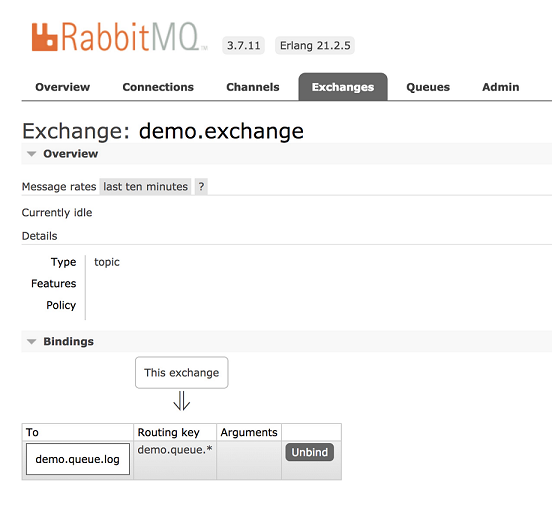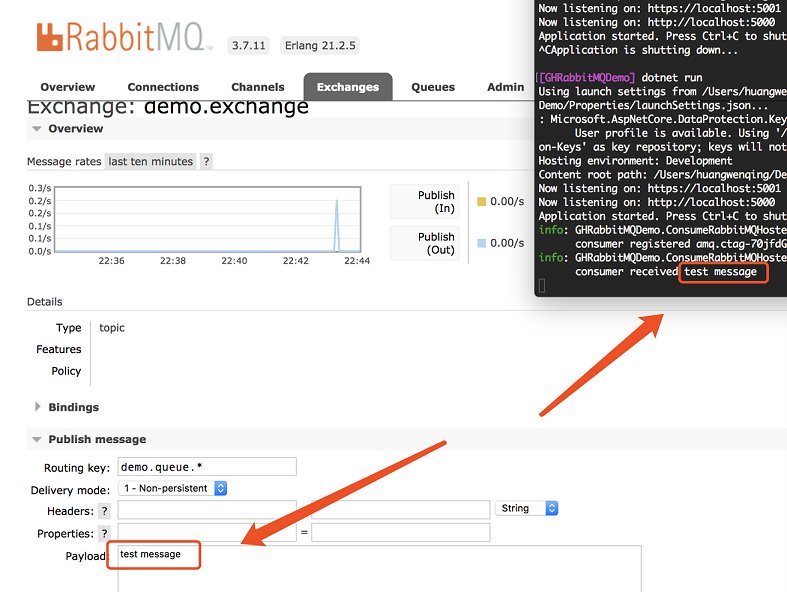
March 26, 2019 11:42 by
 Peter
PeterBackground tasks play a very important role when we are building a distributed system. The most common scenario is consuming the service bus's message. In this article, I'd like to present how to consume the RabbitMQ message via BackgroundService in ASP.NET Core.
Run RabbitMQ Host
We should set up an instance of RabbitMQ. The fastest way is to use Docker.
docker run -p 5672:5672 -p 15672:15672 rabbitmq:management
After running the Docker container, we are able to view the management page via http://localhost:15672.

Consuming RabbitMQ Messages In ASP.NET Core
Setup the BackgroundService
Here, we create a new class named ConsumeRabbitMQHostedService that is inherited from BackgroundService.
BackgroundService is a base class for implementing a long-running IHostedService. It provides the main work needed to set up the background task.
Here is an example to demonstrate how to consume RabbitMQ messages.
public class ConsumeRabbitMQHostedService : BackgroundService
{
private readonly ILogger _logger;
private IConnection _connection;
private IModel _channel;
public ConsumeRabbitMQHostedService(ILoggerFactory loggerFactory)
{
this._logger = loggerFactory.CreateLogger<ConsumeRabbitMQHostedService>();
InitRabbitMQ();
}
private void InitRabbitMQ()
{
var factory = new ConnectionFactory { HostName = "localhost" };
// create connection
_connection = factory.CreateConnection();
// create channel
_channel = _connection.CreateModel();
_channel.ExchangeDeclare("demo.exchange", ExchangeType.Topic);
_channel.QueueDeclare("demo.queue.log", false, false, false, null);
_channel.QueueBind("demo.queue.log", "demo.exchange", "demo.queue.*", null);
_channel.BasicQos(0, 1, false);
_connection.ConnectionShutdown += RabbitMQ_ConnectionShutdown;
}
protected override Task ExecuteAsync(CancellationToken stoppingToken)
{
stoppingToken.ThrowIfCancellationRequested();
var consumer = new EventingBasicConsumer(_channel);
consumer.Received += (ch, ea) =>
{
// received message
var content = System.Text.Encoding.UTF8.GetString(ea.Body);
// handle the received message
HandleMessage(content);
_channel.BasicAck(ea.DeliveryTag, false);
};
consumer.Shutdown += OnConsumerShutdown;
consumer.Registered += OnConsumerRegistered;
consumer.Unregistered += OnConsumerUnregistered;
consumer.ConsumerCancelled += OnConsumerConsumerCancelled;
_channel.BasicConsume("demo.queue.log", false, consumer);
return Task.CompletedTask;
}
private void HandleMessage(string content)
{
// we just print this message
_logger.LogInformation($"consumer received {content}");
}
private void OnConsumerConsumerCancelled(object sender, ConsumerEventArgs e) { }
private void OnConsumerUnregistered(object sender, ConsumerEventArgs e) { }
private void OnConsumerRegistered(object sender, ConsumerEventArgs e) { }
private void OnConsumerShutdown(object sender, ShutdownEventArgs e) { }
private void RabbitMQ_ConnectionShutdown(object sender, ShutdownEventArgs e) { }
public override void Dispose()
{
_channel.Close();
_connection.Close();
base.Dispose();
}
}
Configure Services
We should configure this hosted service with the background task logic in ConfigureServices method.
public void ConfigureServices(IServiceCollection services)
{
// others ...
services.AddHostedService<ConsumeRabbitMQHostedService>();
}
Result
After running this app, we may get the following output in the terminal.Turning to the Management UI of RabbitMQ, we find that it creates a new exchange and a new queue.

The next time we try to publish a message to show the background task is running well, we get the following result.

